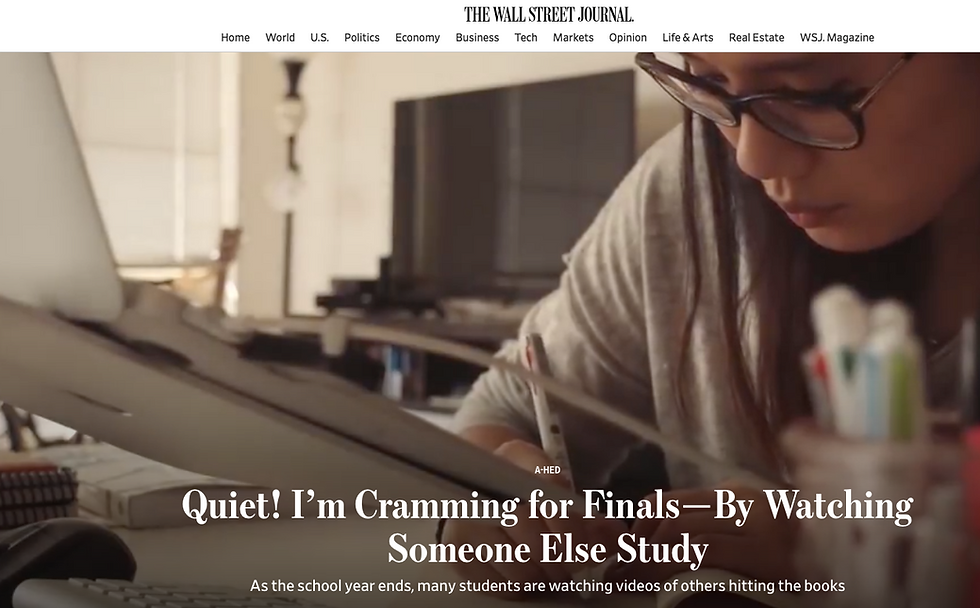A-Hed: Quiet! I'm Cramming for Finals—By Watching Someone Else Study
- THE WALL STREET JOURNAL
- Jun 3, 2018
- 4 min read

By HILARY POTKEWITZ
The video opens with medical student Jamie Lee at her desk, working on a computer and writing in a notebook. In the eighth minute, she pulls her hair up into a ponytail. At 11:20, she adjusts her glasses. She says nothing. She doesn’t leave her seat. She never looks at the camera. This 53 minutes of footage has been watched almost 500,000 times.
As the school year comes to a close, lots of students are cramming for finals. Some are doing it on camera.
In a tidy corner of the internet, a diligent class of students film themselves studying and post the videos online. They solve problem sets, revise worksheets, color-code notes and make flashcards—inviting viewers to study with them.
Some of the videos last a few minutes and include voice-over narration. Others can last hours with only ambient sound. A 2.5-hour study session by Ms. Lee has been watched 877,000 times. She spends most of that one highlighting in a textbook. The New York-based Ms. Lee’s online channel, called TheStriveToFit, has 278,000 subscribers, who receive updates when she posts something new.
These study videos aren’t tutorials. Their stars sit at their desks, sometimes without saying a word. And they aren’t amateur study hour, either: Many of the videos feature high production values, tight editing and multiple camera angles.
After filming a 25-minute study session at his college library in Iowa, Thomas Frank, 26, says he was unhappy with the sound quality of the background noise. So he edited it out. “All the ambience you hear is actually a recording of some library in Norway that I found online,” he says.
Mr. Frank, who also makes short videos on improving productivity, setting goals and managing student debt, has one million subscribers to his YouTube channel.
Grayson Miller, who just finished her sophomore year of high school in Columbia, S.C., subscribed to the channel of a studying star called Studyquill six months ago for inspiration.
“I get a notification as soon as she uploads a new video,” Ms. Miller says. “She’s so neat and organized. Her videos make me want to make my information neater overall. I think it motivates me to put more time into school work.”
Studyquill’s channel, launched in 2016, is known for having font-worthy handwriting, colorful study outlines and detailed planning notes. It has 273,000 subscribers. Its creator is Jasmine Shao, a 16-year-old from the Bay Area who also posts videos about calligraphy, stationery and her favorite school supplies.
“I’m really honored,” she says. “I’m pretty introverted so it’s weird to think that I’m able to affect people across the country and even the world.”
Some students may feel isolated when they’re up late studying. Having a video on in the background can feel like having a study buddy.
“I think the people making these videos are tapping into a need where you want to be social without being disrupted from your study goals,” says Mitchell Nathan, professor of educational psychology and learning sciences at the University of Wisconsin-Madison. “Think of it like parallel play. This is parallel studying: You’re ignoring each other, but that’s still much more preferable than doing it all by yourself.”
In the U.S., views of so-called study-with-me videos tripled in 2017 from 2016, according to YouTube, which won’t disclose total numbers. With a young, engaged audience, it was only a matter of time before grown-ups (i.e. marketers) noticed.
Last year, 17-year-old Seo Jung, from Camas, Wash., received a call from Muji, a Japanese brand known for its pens and notebooks, seeking a sponsorship deal.
Ms. Jung, known on YouTube as tbhstudying, (139,000 subscribers) took it in stride. She had already done sponsorship deals with Skillshare, an online learning platform, and Quizlet, a mobile study app.
“I read through the contracts and do research,” she says. “Then I make my decision and let my parents know.”
She declines to reveal her YouTube earnings, but says she puts half of it into savings.
Muji USA has cut deals with a few online study stars, spokeswoman Celine Vaaler said. “A lot of people were naturally promoting Muji without any paid partnership, and the content was really well done. We saw it as a great opportunity.”
The sponsorship rates tend to be “modest,” Ms. Vaaler says, starting at about $100 per 10,000 views, plus products or gift cards. “They’re younger, often living with their parents. This isn’t their full-time job.”
But Jade Bowler, a study tube star from England known online as UnJaded Jade, (187,000 subscribers) is taking things up a notch: She has an agent. Danny Lowney, the 24-year-old managing director of Sixteenth Talent Agency, handles Ms. Bowler’s media and promotional requests, of which there are many, he says.
Sponsorship rates start at $1,000, he says, while a multiplatform arrangement could run to $10,000. “Or more, of course,” he says.
Mr. Lowney has arranged about five commercial sponsorships for his client so far, including one with meditation app Stop, Breathe & Think, and another with consulting firmAccenture encouraging primary-school girls in science, technology, engineering and math.
Ms. Bowler describes herself as a “non-preachy, 18-year-old vegan.”
“I never started my channel for money, and I wouldn’t work with a brand whose ethics I disagree with,” she wrote in an email.
Behind their successful channels, most are just typical students trying to balance work and extracurricular activities. Some are still adjusting to their newfound celebrity.
Occasionally one of Ms. Jung’s teachers will call out, “I liked your new video!” as she exits class, she says. “When that happens, I blush and say thank you and try to leave quickly.”
Thomas Frank’s ‘Study With Me—A 25-Minute Pomodoro Session’
A video from Jasmine Shao’s studyquill YouTube channel titled ‘Study With Me: 8-Hour Workday’
A video from Seo Jung’s tbhstudying YouTube Channel.
A study video from Jade Bowler’s UnJaded Jade YouTube Channel.




Comments